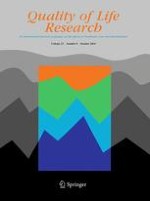01-10-2014
Improving the mapping of condition-specific health-related quality of life onto SF-6D score
Gepubliceerd in: Quality of Life Research | Uitgave 8/2014
Log in om toegang te krijgenAbstract
Background
This study sought to improve the predicative performance and goodness-of-fit of mapping models, as part of indirect valuation, by introducing cubic spline smoothing to map a group of health-related quality of life (HRQOL) measures onto a preference-based measure.
Methods
This study was a secondary analysis of a cross-sectional health survey data assessing the HRQOL for patients with colorectal neoplasms. Mapping functions of condition-specific functional assessment of cancer therapy—colorectal (FACT-C) onto preference-based SF-6D measure were developed using a dataset of 553 Chinese subjects with different stages of colorectal neoplasm. The missing values of FACT-C were imputed using multiple imputation. Then three widely applicable models (ordinary least square (OLS), Tobit and two-part models) were employed for the mapping function after applying the cubic spline smoothing on the data. For the evaluation of the effectiveness of cubic spline smoothing and multiple imputation, the goodness-of-fit and prediction performance of each model were compared.
Results
Analyses showed that the models fitted with transformed data from cubic spline smoothing offered better performance in goodness-of-fit and prediction than the models fitted with the original data. The values of \(R^2\) were improved by over 10 %, and the root mean square error and the mean absolute error were both reduced. The best goodness-of-fit and performance were achieved by OLS model using transformed data from cubic spline smoothing.
Conclusions
Cubic spline smoothing and multiple imputation were recommended for the mapping of HRQOL measures onto the preference-based measure. Among the three mapping models, the simple-to-use OLS model had the best performance.
